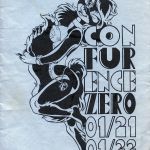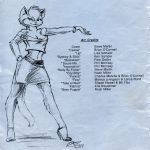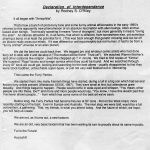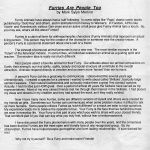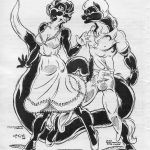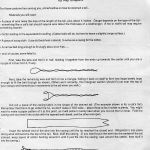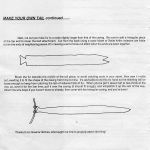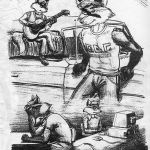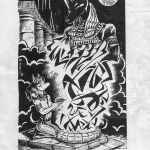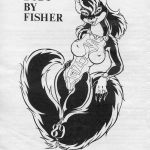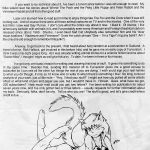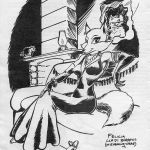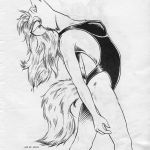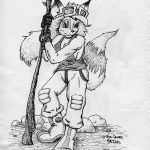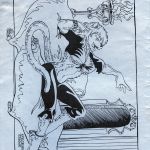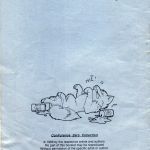Art Credits
Steve Martin
Brian O’Connell
Lisa lennaco
Ken Sample
Pete Stoller
Phil Morrisey
Phil Morrisey
Steve Martin
Noah Miller
Charles Melville & Brian O’Connell
Monica Livingston & Lance Rund
Shawn Howell & Bill Fitts
Kris Kreutzman
Noah Miller
Declaration of Interdependence
by Rodney S. O’Riley
It all began with “Xenophilia”.
That’s how a bunch of proto-furry fans and some funny-animal afficionados in the early 1980’s referred to this apparently new phenomenon of an absolute fascination with alien beings, often animal- based alien beings. Technically speaking it means “love of strangers”, but more generally it means “loving the alien”. An intense attraction to, in all terms, that which is different, from somewhere else, yet somehow sharing a bond, or at least the potential for it. (This was back enough that genetic crossing was too far off an idea to really cross our minds. If it was different or anthropomorphic-but-not-human, it had to be from a “funny animal” universe or an alien planet).
We did the best we could back then. We begged pro and amateur comic artists who had done furry art to stick with it and develop it (“The market will be there! Trust us!”). We watched Warner Brother’s and other cartoons like religion – even the chopped-up T.V. reruns. We tried to find copies of “Kimba”.
We hoarded “Pogo” books and foreign comics when they could be found. And we searched through every SF book we could get, looking and searching for the best aliens – usually disappointed to find they were stock baddies, untouchable super-types, or just not very well fleshed out or interesting.
Then came the Furry Parties.
We started them, like many Fannish things have started, during a lull in a big con which had several known furry artists present (Westercon XXXIX, 1987). They were small at first, but attendance grew steadily. And things began to happen. People would come in wide-eyed and whisper, “You mean, other people are into these, too?” and more and more people would say, “You know, I have this sketch pad that I’ve never shown people…” – from which has come some of the best art we’ve seen.
Before long, the Furry Parties had become fixtures at SF cons – first on the West coast, more recently starting on the East. Even in Europe and Australia. The next step, we were told, would be a full convention, a gathering. That, my friends, is what you attend today. And the future of which, we hope, you will help us create.
We are not, as it turns out, a new fandom.
We are an old, very basic fandom that has been waiting its turn to proudly shout its name in public.
Fur is the Future!
Huzzah!!!
Furries 4 are People Too
by Mark Sylys Merlino
Funny Animals have always had a ‘cult’ following. In comic strips like ‘Pogo\ classic comic books published by ‘Gold Key’ and others, and in animation from Disney to Warner’s. In Fandom, APA’s like Vootie and Rowrbrazzle, various Gen-zines and an active small press give Funny Animal fans a forum. So, you may ask, what’s all this about Furries?
Furries is a catch-all term for anthropomorphic characters (Funny Animals) that represent an actual living person. This person may be the creator of the character or someone else the creator knows. A person’s Furry is a personal statement about one’s-self or a friend.
The concept of personal animal personas is not a new one. The most familiar example is the ‘Totem’ of the American Indians. In some tribes, an individual selected an animal as a guiding spirit and teacher. The modern idea is really not much different.
Most people select a favorite animal for their Furry. Our attitudes about our animal companions on Earth; their strength, survival ability, agility, beauty and social structure all contribute to the overall attraction. Animals respond directly to emotion and so seem more ‘honest’ than we humans.
A person’s Furry can be a great way to communicate. I discovered this several years ago unintentionally. I created a species for a universe I wanted to write about called ‘Skiltaire’, basically large sentient weasels. Their natural fearlessness and curiousity make them a great ‘first contact’ species. Actually, I had no idea just HOW great. Over a period of almost 20 years the Skiltaire have served as my representatives. Most of my very closest friends met me through their interest in the Skiltaire. I had placed my ideas and dreams in my creation and they had spread the word, as if they really existed.
Now I have many more Furries, some are different versions of myself and others were created for my friends as gifts. Sometimes our Furries can communicate when some problem makes it difficult to talk as mere humans. Some people criticize Furries as ‘wish-fulfillment’ or a mask we wear to hide ourselves. My experience leads me to believe the opposite is true. Your Furry is the face that lies behind the mask we wear in everyday life. Your Furry is that part of you which you wish to share with your closest friends. That confident part of you that can say what you truly feel, without fear of embarrassment.
I have discussed the Furry phenomenon with many people over the years, and the consensus has been that the Furries are the most open and friendly fans of any recognized group. By my observation, Furries have helped people get together and form lasting relationships. It sure worked for me!
Why not try it yourself? Be a Furry and make some Friends!
Make. Your Own Tail
by Kay Shapero
For those costume fans among you, a brief outline on how to construct a tail…
Materials you will need:
• A piece of wire twice the size of the length of the tail, plus about 4 inches. Gauge depends on the type of the tail –
– something like a cat’s tail should require wire about the thickness of a coathanger; A fox or wolf’s tail may require
something heavier.
• Cotton batting or the equivalent for stuffing. (Cotton balls will do, but tend to leave a slightly lumpy surface.)
• A piece of scrap cloth (I use old bedsheet material) to serve as a casing for the cotton.
• A narrow belt long enough to fit snugly about your hips.
• and, of course, some fake fur.
First, take the wire and fold it in half, twisting it together from the ends up towards the center until you are a couple of inches from it, thusly:
Next, take the remaining wire and form it into a triangle, folding it back on itself to form two loops barely large enough to fit the belt through as shown. (When worn correctly, this triangular section should fit just over the top of your coccyx and transmit your movements to the tail when you walk.)
Cut out a piece of the casing fabric in the shape of the desired tail. (The example shown is for a cat’s tail.) Remember that this is to go under the fur, so don’t make it TOO wide — about three to four inches is plenty. You might want to make a paper pattern of it at this point, as it will come in handy later when you cut out the fur cover. Fold the casing over and sew it into a tube with the tapered end closed, and the other end open.
Insert the twisted end of the wire into the casing until the tip reached the closed end. Whipstitch it into place along what will become the top of the tail. Now, stuff the casing. (If you want to put the wire into the center of the tail instead, wrap layers of cotton banting around it until it just fits into the casing, sew around the cotton, then stuff it into the casing.)
MAKE YOUR OWN TAIL continued.
Next, cut out your fake fur to a scale slightly larger than that of the casing. Be sure to add a triangular piece at the top end to cover the belt attachment. Cut from the back using a razor blade or Xacto knife: scissors are liable to trim the ends of neighboring pieces of fur leaving a sort of crew-cut effect when the ends are sewn together.
K
Brush the fur towards the middle of the tail piece, to avoid catching ends in your seam, then sew it inside out, everting it to fit the shape of the casing from time to time. It’s advisable to do this by hand so the stitching will be loose enough to keep from catching the tips of adjacent bits of fur. When you’ve got it about half to two-thirds of the way up, evert it for the last time, pull it over the casing (it should fit snugly), and whipstitch it up the rest of the way. Attach the wire loops if you haven’t done so already, then cover with the triangular casing, and you’re done!
Thanks to Liz Greene Holmes, who taught me how to properly attach the thing!
Why?
by Ken Sample
“Why do you like to draw Furries?”
It’s a good question. Why do I like to draw them?
It’s not like some people think: “They’re easy to draw.” That’s a load of bunk. Furries, or Exotics as I like to call the kind I usually draw, are DIFFERENT to draw, but not easy. Ask anyone who draws Furries, Funny Animals or whatever you want to call them. I can draw people. But usually, that’s not as much fun.
There’s SOMETHING about furry people that’s exciting. Stimulating is probably a better word.
My interest in Furries probably stems from a like for mammals; cats, dogs, rabbits. The usual group of attractive animals. It stems partly from my love of animation and the characters derived from that most fascinating mode of visual storytelling. The old Warner Brothers characters and the like.
I started on to drawing furries in 1977. I will freely admit that I was turned on to drawing furries by the characters from Filmation Animation’s “The Secret Lives of Waldo Kitty” and animated “Star Trek”. The character designs interested me. I was already a cat fan by then, and in these shows were some interestingly different ones. I used to spend a lot of time trying to refine my handling of Catzen and Lady Vain and Lt. M’Ress.
I was, and still am, a fan of the Marvel and DC type of comic books, and I would draw superheroes all over the place. But, I was attracted mostly by the heroes and villains who displayed animal powers: The Beast, Tigra, Black Panther, Spider-Man, and the like. I used to draw my own heroes, one called The Puma in particular. But, there was something missing from the guy in the tight cougar costume. He wasn’t quite right.
1977 was also the year when I read my first Sci-Fi novel featuring a Furry. The book was Richard Meyer’s “Doom Star” and I was then and forever taken by the felinoid, Napoleon. She was intelligent, capable, tough and sexy. An incredible portrayal of character. The character was so real to me, such a wonderful personality. I HAD to see what she looked like.
I realized then what was missing from my superhero characters. The FUR. There is something about fur that keeps the characters from becoming typical. That idea hooked me and I’ve been hooked since.
So I’m a dedicated Funny Animal, Recom, Skiltaire, Furry Alien artist. I can’t tell you why I like to draw Furries It’s too deep to root out. And I don’t think it’s worth worrying about. I do what I like, without hurting anyone with it. I have fun, and somehow, it makes some people happy. I guess I can’t ask for much more than that.
BODY BY FISHER
The Making Of A Furvert
by Rudy Minger
If you want to be technical about it, I’ve been a furvert since before I was old enough to read. My folks would read me stories about Winnie The Pooh and the Poky Little Puppy and Peter Rabbit and the Velveteen Rabbit and all that other good stuff.
Later on I learned how to read just in time to enjoy things like The Fox and the Crow when it was still coming out. And of course there were all those animal cartoons on TV and in the movies. One of the very first films I saw was Gay Purree. I don’t care what the critics say about it now. I liked it. Of course, I like almost any cartoon with animals in it, and I’ve probably seen every American and Foreign theatrical cartoon released since about 1960. Shucks, I even liked Sad Cat (Anybody else remember him and his “dear mean brothers,” Vladimore and Fenimore? Does the catch phrase “Gee — I’m a Tiger 1 ‘ ring any bells? Am I the only one old enough to remember this junk?)
Anyway, to get back to the present, I first heard about furry fandom at a convention in Oakland. A friend of mine, Rick Hallock, got involved in this before I did, and he gave me an early copy of Furversion. I think it was only eight pages long. As I was already writing animal stories for a science fiction fanzine about “Doctor Moo”, I thought I might as well give this a try. To date, I’ve been in three or four issues.
I’ve got only one basic reason for writing and drawing this kind of stuff. It gives me something to do in my spare time. Besides that, sending this material off to Furversion gives me a good excuse to subscribe so I can see all the other fun things the rest of you are doing. I wish you’d sign your real names to what you do though, if only so I’d know who to write to when there’s something I like! No long, tortured analysis of your work, just a little note — “Hey, I liked your stuff!” I might ask how you pulled off some artistic effect or what kind of pen and paper you use, but I wouldn’t move in. Honest. Geez, what have we got, 200 subscribers? How much mail could you get, two letters? I’ve been writing for publication for about seven years now, and I’ve only gotten two or three letters — usually requests for further information about my topic. Seriously, folks, don’t be shy. Tell us who you are! The stuff is good, and let’s give credit where credit is due.
ConFurence Zero Collection
